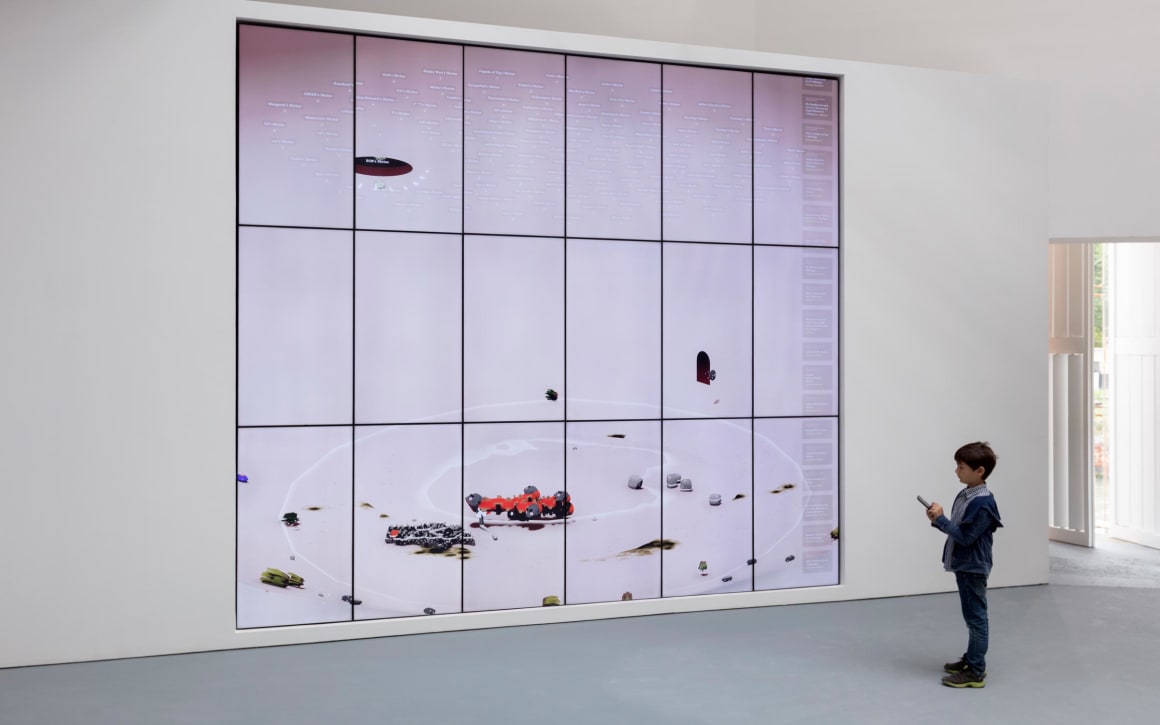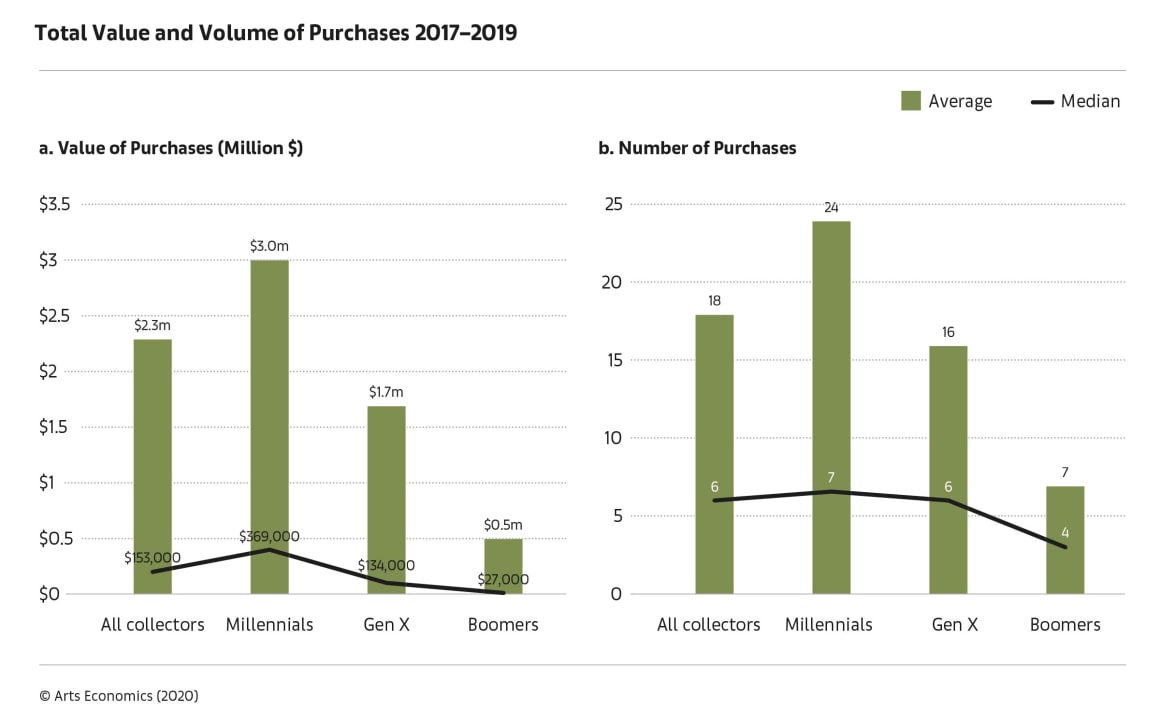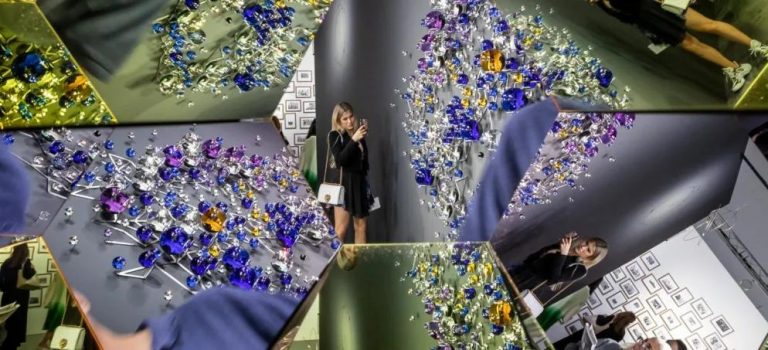Source: Art Basel.
Millennials’ preferences have revolutionized everything from ride sharing and food delivery to sneaker shopping and dating, but the art industry has, so far, been slow to keep pace. Finally, however, there is evidence that younger people are taking a strong interest in collecting art – and changing the channels through which it is sold.
As revealed in the 2020 edition of The Art Basel and UBS Global Art Market Report, High Net Worth (HNW) millennials are now the fastest-growing constituency of collectors, and at the top end of the market, they buy more art and spend more on it than any other demographic.
The full, detailed findings of The Art Market 2020 – the only annual, comprehensive analysis of an industry valued at $64.1 billion, authored by cultural economist Dr. Clare McAndrew and published by Art Basel and UBS – can be viewed here.
In recent years, galleries have become extremely focused on attracting and retaining the attention of millennials (currently aged between 23 and 38), a generation that is famously cash- and time-poor. So how best to engage this younger audience? According to the New York-based art advisor Heather Flow, of whose clients approximately 70% fall within the demographic, precision is key. ‘Truly engaging millennial collectors requires galleries to rethink ideas of transparency, flexibility, diversity, and sustainability,’ she says. ‘The gallery business model must adapt to consider these elements.’
Millennial buyers view art through a prism of social and investment values. Flow notes how the collecting tastes of millennials, as with boomers (aged 55 to 73) in the 1960s and ’70s, are tied to the dynamic social and political changes of the time. ‘I think you can see a parallel between the older generation’s openness to photography and mixed media, and millennials’ interest in video and new media,’ says Flow. ‘The reality that we live in shapes our understanding and comfort level with materials.’
While buyers aged between 40 and 64 still represent the biggest segment for dealers (accounting for 62% of all buyers in 2019, according to The Art Market 2020), the biggest growth year-on-year was seen in collectors under 40, having increased by 6%, to 19%. Of this, the contemporary sector had the largest share of younger buyers, with 21% of contemporary collectors being under 40.

Installation view of Ian Cheng, BOB (Bag of Beliefs), 2018-2019, at the Venice Biennale 2019. Photo by Andrea Rossetti.
Collector Paul Leong – whose collection includes Wolfgang Tillmans, Klara Lidén, Ian Cheng, and Jill Mulleady – made his first significant art purchase at Art Basel Miami in 2011. As with many of his peers, social and shared experiences, such as forming relationships with artists and supporting foundations and museum groups, play a key role when he is buying art. ‘I’m fortunate to know many of the artists I collect personally,’ says Leong. ‘The artworld is a large part of my social life – it’s one of the biggest and best surprises to come out of collecting.’
Transparency is also a priority for Leong, who seeks to form a symbiotic relationship between collector and gallery. But he sees the proliferation and easy availability of data as double-edged: ‘Many more people on a global scale can learn about new artists quickly or be exposed to images on social media. This sometimes results in increased demand and possibly market bubbles, which ultimately makes it harder to collect artists in depth.’ McAndrew’s report shows that platforms that provide prices are more likely to achieve sales.
The trend is most pronounced among HNW collectors. Here, McAndrew’s analysis found that millennials purchased the most and spent the most, averaging a total expenditure of $3 million over two years, more than six times the spending of boomers. Of those most commonly spending more than $1 million, 69% were millennial collectors, a significant increase from 41% in the 2018 survey.
This generational shift has brought with it a gender shift. Female collectors reported a significantly higher average spend than their male counterparts, with 34% of women spending more than $1 million in the past two years versus 25% of men.

Surveys of more than 1,300 HNW collectors conducted by Arts Economics and UBS Investor Watch in seven markets (the US, UK, France, Germany, Singapore, Hong Kong, and Taiwan) indicated that millennial collectors purchased the most and spent the most.
Unsurprisingly, younger collectors are also the motor behind the artworld’s move online, seen in the recent increase in new digital presence, from Instagram-only galleries to Art Basel’s Online Viewing Rooms, which will launch later this month. Asked in the survey if they had bought online, 92% of HNW millennial collectors said they had, compared with less than half of boomers. The generation gap was further pronounced when it came to Instagram. McAndrew writes that the app has become a crucial marketing tool, generating interest and confidence in artists and galleries. While the majority of millennials had used Instagram as part of their collecting process, nearly three-quarters of boomers had never used the social network when buying art.
Looking forward, the buying power and influence of millennials is only set to grow, as wealth – including art collections – is inherited from their elders. Dealers surveyed by McAndrew suggest that the modern collector ‘cross-collects, purchases from multiple channels […] and is very comfortable selling works that may not suit their collection,’ meaning greater fluidity in the marketplace is a likely outcome from this handover to the younger generation.
When it comes to continuing to attract new collectors, for Flow, it’s all about lifestyle. ‘Millennial collectors’ understanding of connoisseurship is largely defined by the communal,’ she says. ‘The strength of this effect will force institutions to reconsider modes of traditional exhibition-making and collecting and move towards a more innovative, fluid, and diverse methodology.’

A detail from Goin To A Go-go!!, 2014, by Japanese artist Mr., on view at Kaikai Kiki Gallery, during Art Basel Hong Kong 2019.
Key Findings of The Art Market 2020
- Global sales of art and antiques reached an estimated $64.1 billion in 2019, down 5% year-on-year, returning the market to just above its 2017 level.
- The three major art hubs, the US, the UK, and China, continued to account for a majority of the value of global sales in 2019. The US market was the largest market worldwide once again, accounting for 44% of global sales by value.
- Sales in the gallery and dealer sector were estimated to have reached $36.8 billion in 2019, growing just over 2% year-on-year.
- Sales at public auction of fine and decorative art and antiques reached $24.2 billion in 2019, down 17% year-on-year as values decreased in the key global auction hubs.
- Art fair sales were estimated to have reached $16.6 billion in 2019. The share of dealers’ annual sales by value made at art fairs has grown from less than 30% in 2010 to 45% in 2019.
- Online sales of art and antiques were estimated at $5.9 billion in 2019, a decline of 2% year-on-year, although still at their second highest ever level.
Download The Art Market 2020 here, for free.








